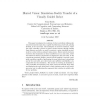Free Online Productivity Tools
i2Speak
i2Symbol
i2OCR
iTex2Img
iWeb2Print
iWeb2Shot
i2Type
iPdf2Split
iPdf2Merge
i2Bopomofo
i2Arabic
i2Style
i2Image
i2PDF
iLatex2Rtf
Sci2ools
EVOW
1998
Springer
1998
Springer
Blurred Vision: Simulation-Reality Transfer of a Visually Guided Robot
This paper investigates the evolution of robot controllers utilising only visual environment input data, capable of performing a hard task, playing football, in the real world. The techniques of minimal simulation, where the robot controller is forced to ignore certain features through making those features unreliable, are used to construct a noisy simulated environment for a robot with an onboard vision system. Robot control structures evolved in this simulation are then transferred on to a real robot, where the behaviours shown in simulation are displayed in the real world. In the experiment presented, finding a tennis ball and pushing it towards a goal, good controllers capable of performing the same behaviours in simulation and in the real world, are evolved only once sufficient unreliability is incorporated into the simulation. The success in evolving in simulation a robot controller incorporating only distal visual environment input data and displaying the same behaviours in bot...
| Added | 05 Aug 2010 |
| Updated | 05 Aug 2010 |
| Type | Conference |
| Year | 1998 |
| Where | EVOW |
| Authors | Tom M. C. Smith |
Comments (0)

